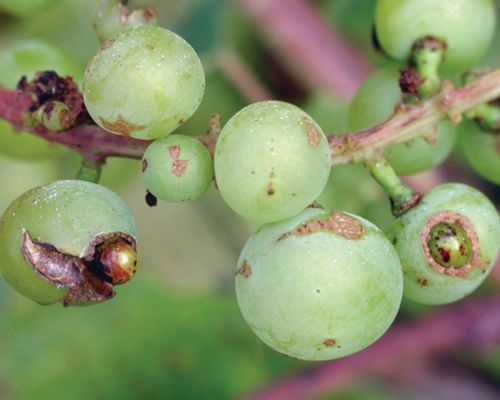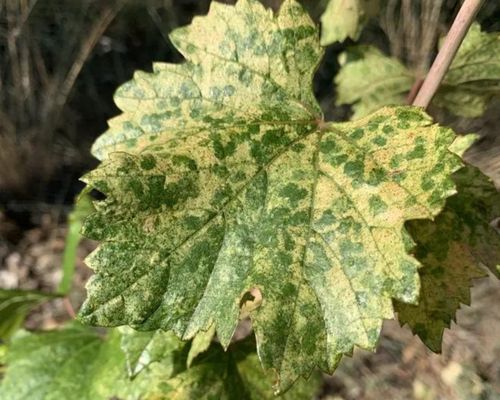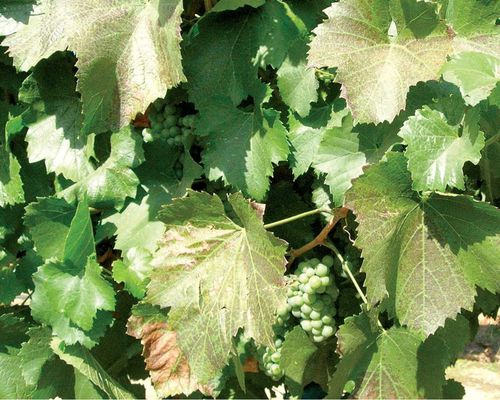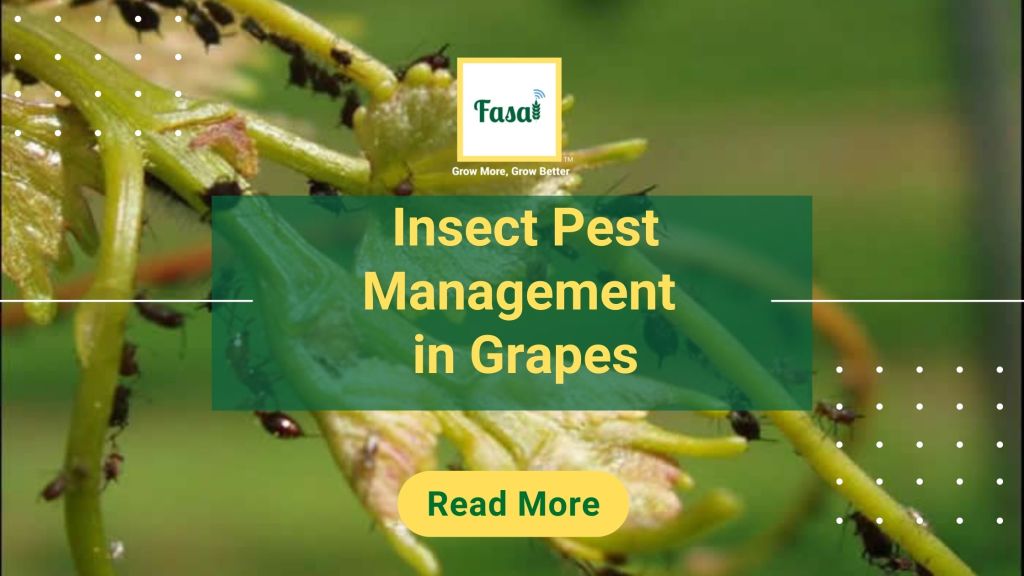This blog gives you a fair idea of the major insect pests attacking grapes in India. You will also learn how to identify and manage them better.
Grapes are one of the most commercially cultivated crops in the world. The invasion of a wide range of insect pests at various crop stages is one of the difficulties in the production of grapes. Locating pests in the vineyard as soon as possible is essential to stop significant outbreaks and quality losses.
Therefore, pest management is crucial when cultivating grapes.
Major pests in grapes are
Thrips
Symptoms
- Nymphs and adults inflict damage by sucking the leaking cell sap and rasping the bottom surface of the leaf with their styles.
- Numerous tiny spots on the wounded area give the surface a speckled silvery appearance.
- When the attack is significant, the leaves begin to curl.
- The thrips also prey on growing berries and blooms.
- The impacted berries get a corky covering, turn brown, and sell for very little money.

Management
Sanitation
Sanitation must be maintained to eliminate the root causes of thrips infection,
Weeds should be removed from the fields to keep them tidy.
Plant debris from past crops is also a source of secondary thrips infestation.
Cultural
Deep ploughing in the summer after April pruning, or exposing the soil in vineyards to the sun, aids in destroying its pupal stages and reducing its incidence.
Biological
The lacewing, green Chrysoperla carnea is a predator of insect pests in vineyards. Spraying fungal pathogens aids in thrips population reduction in cold and humid climates, particularly when temperatures are between 20-25°C and humidity is above 80%.
Mealybugs
Symptoms
- The deformation of leaves and shoot tips is caused by an infestation of the growth of pink mealybug.
- Mealybug nymphs and adults emit honeydew, which promotes the development of sooty mold on leaves, stems, and bunches.
- Mealybug-infested, sooty and sticky bunches with white cottony wax masses are unsuitable for sale as table grapes.
- Such contaminated bunches cannot be used to make raisins.
- The pest attack weakens the mature vines.
- Young vines frequently perish in cases of severe mealybug infestation.
- In severe circumstances, the grape mealybug can result in up to 100% vineyard losses.

Prevention
- When the crop is harvested in March or April, mealybug-infested bunches should be collected and destroyed.
- In April or May, remove and destroy all of the garden debris that was clipped after a mealybug infestation.
- In April or May, loose bark should be removed, and the material should be destroyed.
- Removal of weeds and other host plants that shelter mealybugs in and around vineyards all year.
- Finding the ant nests and eradicating them with a drenching of herbicides
Grape Leaf Hoppers
Symptoms
- When a larva is grown enough, it folds a leaf to reveal the underside, holding the edge in place with bands of silk thread.
- The larva feeds within the shelter of this fold, decomposing the upper surface of the leaf to its skeleton.
- The damage to the vine becomes noticeable when there are many larvae, even from a great distance, because the pale hue of the folded leaves’ undersides stands out sharply against the dark green of the normally exposed top side, giving the vine a patchwork appearance.

Management
- Natural Enemies of the Grape leafhopper are scarce. A contact pesticide may be required when the pest is present in large numbers.
- Removing basal leaves or lateral shoots during berry set and the two weeks following (before mature leafhoppers emerge) will often reduce peak leafhopper populations by 30–50%.
- During the first generation nymphal life cycle, up to and including the fifth instar, time leaf removal happens just before adults start to emerge.
- Additionally, removing leaves will increase pesticide coverage and effectiveness.
- Avoid removing too many leaves when growing plants in warmer climates because this can result in burnt fruit.
- Keeping vines from growing too quickly will also help control leafhoppers.
Spider mite
Symptoms
- The upper surface of the leaves typically exhibits pale colour spotting as the most obvious sign of this damage.
- The infested leaves become yellow. In severe infestations, the mites can consume up to 70% of the chlorophyll, which results in the development of brown burnt areas on the infected leaves, which eventually wither and dry.
- Reduced photosynthesis caused by leaf discoloration affects the health of the plants. Mites are normally visible over the drying leaves and create a very fine, silk-like webbing.
- Later, the mites disperse to feed on developing shoots. Table grapes’ berries turn amber because of a mite infestation that produces heavy leaf fall. A severe spider mite infestation delays cane maturation, slows bunch ripening, and lowers sugar content, which impacts the crop’s quality.

Prevention
- Sanitation must be practiced to get rid of the mite infestation’s sources. After pruning, plant waste can serve as a breeding ground for adult and immature mites. Thus it is essential to remove it.
- Most mites will presumably be found in weedy vines. Therefore, getting rid of weeds and other host plants in and around the vineyard is important.
- Chemicals are the primary means of controlling mites on grapes. The control of mites depends heavily on the timing of applications.
How can Fasal assist?
- A vicious grape pest can devastate a vineyard in just a few days.
- With the help of Fasal’s technology, pests like thrips, leafhoppers, mealy bugs, and others are no longer a danger to your vineyards.
- The precision agriculture-based technology from Fasal offers proposals for site-specific, time-specific, location-specific, and crop-specific solutions.
- The Fasal system keeps track of rainfall, humidity, temperature, and humidity for the canopy moisture level, as well as a microclimatic prediction for pests like thrips, whiteflies, aphids, and others, to warn farmers when the conditions are favorable for pest infestation.
- Fasal technology generates a number of management plans and suggests fixes based on the unique circumstances of a farm.

Leave a comment